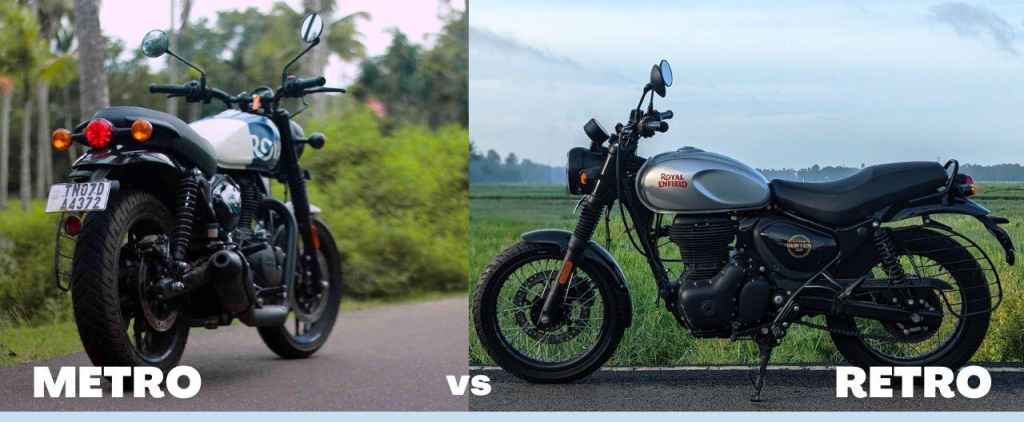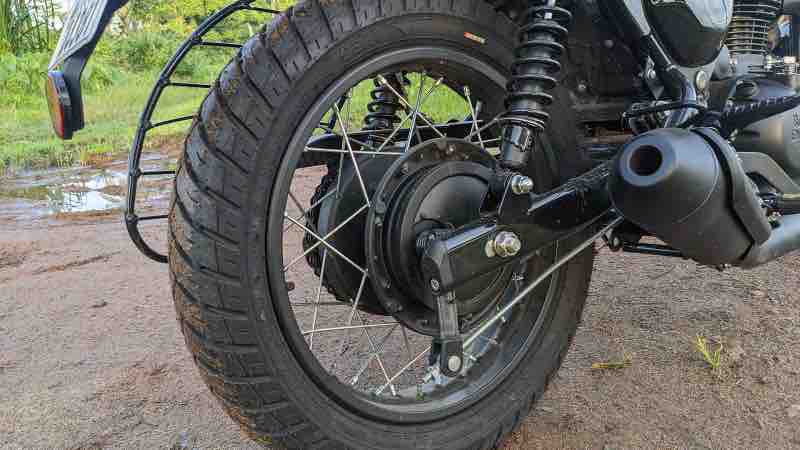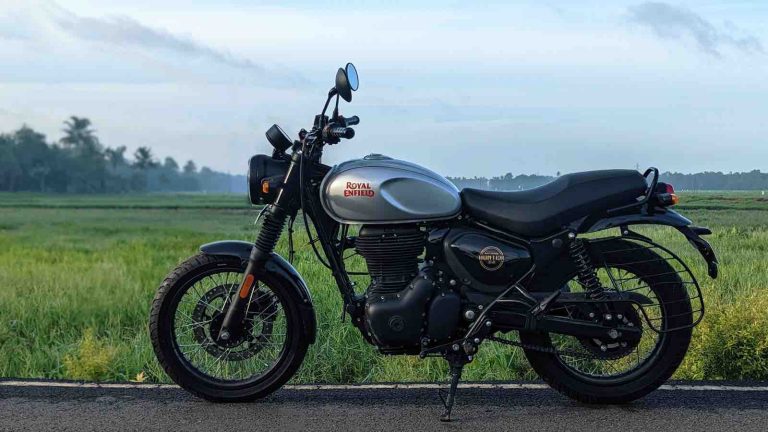How good is the Royal Enfield Hunter 350 Retro variant? Let’s find out…
Photography: Sarath S
‘Making it accessible to a wider spectrum of buyers’ is something Royal Enfield was very particular about while developing and placing the Hunter 350. The motorcycle that is currently in huge demand thus comes in two distinct variants- Retro and Metro, with the base spec bearing a very aggressive price of Rs 1.49 lakh. These differ on multiple fronts. We had previously reviewed the Metro Rebel and here is the base-spec Retro. Read ahead for answers to all your questions about the Hunter 350 Retro Factory variant.
Table of Contents

Royal Enfield Hunter 350 Retro: A Quick Look At It!
Think of the Retro as a highly stripped-down version of the Hunter. Many of the things you’d love on the Rebel or Dapper editions are replaced with more cost-effective alternatives. This air of being ‘ budget conscious’ is seen at almost all areas of this motorcycle. The upside to this, however, is that this is the Hunter that looks and feels the most old-school. Key highlights include a colourway that looks rather classic, basic but functional designs for all major components – the seat and pillion grab handle could be prime examples, and kit and mechanicals that feel fairly basic.
Royal Enfield Hunter 350 Retro Factory gets 17-inch spoke wheels with slimmer tyres, single-channel ABS with rear drums, sleeker levers, and basic switchgear and instrumentation. Before we get into the ride impressions, take a quick look at how the base variant compares with the top-spec trim.

Royal Enfield Hunter 350 Retro vs Metro Comparison:
The differences between the Metro and Retro variants are many. You get to spot them in the aesthetics, kit levels and even in some mechanical components.
Design: The less expensive Retro variant feels fairly basic in its design. The colourway feels simple and gels well with the overall ‘old school’ persona of the motorcycle. The premium ribbed seat design you’d see on the Metro Rebel makes way for a simpler one on the Retro. The Retro’s seat has more cushioning, while that of the Metro feels a lot firmer.

The pillion-grab handle on the entry-level Hunter feels crude but functional. In fact, it feels slightly better than the Metro’s fancy-looking grab handle in the actual functionality. The motorcycle gets a round headlamp and tail lamp, but rectangular blinkers. The lights are all regular Halogen units on the Retro but the Metro gets LED blinkers.
Wheels are the next big thing. The Hunter 350 Retro comes with old-fashioned (17 inch) spoke wheels and slimmer (110/80-17 (F) 120/80 (R)) tyres. The range-topping Metro variant gets 17-inch alloys with meatier 110/70 section rubber at the front and chunky 140/70 section at the rear- this tubeless tyre-alloy setup is easier to mend in case of a puncture.

The Retro variant gets its core plastics, switchgear and levers from the Bullet 350. These slimmer levers can feel handier than the chunkier ones on the Metro, and could even make the clutch feel slightly lighter. However, I personally prefer the Metro’s levers.
Features: The base-spec Hunter 350 lacks some amount of kit. It gets a fairly basic instrument cluster with a simple-looking analogue speedometer and a small digital screen that offers curated information. You get things like odo and trip meter here. The Metro, however, gets a monopod with better design and functionality. The screen offers much more information there and has a more pleasing design. The gear position indicator is my personal favourite, and also the one that I missed terribly while riding the Retro. The pleasant bit, however, is that both the variants offer USB charging points.
Tripper Navigation- RE’s Bluetooth-based smartphone integration solution, could be added as an accessory as and when the supply crisis eases, on both variants- thus the same shouldn’t be a concern for the buyer.
ALSO READ: 2022 Royal Enfield Hunter 350 Metro Review: ‘Ain’t No RE Stereotype!’
Mechanicals: The powertrain sees no change between the variants. Both the motorcycles get the same 349cc air-oil cooled single as their powerhouse. The J series engine and its map remain almost identical on both the motorcycles. However, the Hunter Retro gets disc brakes only at the front and the rear makes do with a drum. There is thus, just a single channel ABS offered on the lower spec Hunter. Also, it misses out on a main stand. Courtesy of all these, the Retro is lighter than the top-spec Metro by 4 odd kilos- the wet weight being just 177 kilograms.

Royal Enfield Hunter 350 Retro: Ride Impressions
If I am to shout my heart out loud, the Hunter 350 variants feel distinctly different in their dynamics. There is no much difference in the performance or acceleration – which can be a bit weird considering the weight advantage that the Retro has over the Metro. To give you some numbers, the Metro does 0-60 kph in 5.2 seconds and the Retro in 5.1 seconds.
I love the range-topping Hunter variant for how nimble it feels, while on the roll. The motorcycle feels very agile and manageable. It is quite reassuring around corners. We had talked about this in detail in our review of the Metro Rebel. However, the base spec has a slightly different story to tell. The slimmer tyres (CEAT Gripp XL) aren’t as grippy or confidence-inspiring as the bigger Zoom XL rubber on the Metro. You get to feel this the most when you push this motorcycle on wet roads. Around damp corners, the rear could even tend to slip a bit. I had taken the Retro on Royal Enfield’s One Ride recently- and at some point, had to ride through wet corners where I got a clear taste of this.
Another key difference is in the braking performance. The Retro gets drum brakes at the rear and a single-channel ABS. Out on the roads, this setup doesn’t match the Metro’s dual discs and dual channel ABS, in performance. On dry roads, the Retro brakes well. It doesn’t fishtail when you go hard with the brakes, but the Metro does it significantly better- this shouldn’t thus be a deal breaker. On the wets, however, the braking is much more dramatic.
Owing to these reasons, cruising below 80 kph would be the most advisable on the Retro. Of course, it is possible to do 90 kph, but with a lot less confidence than what you’d do on the Metro.
Check out more reviews from us!

Royal Enfield Hunter 350 Retro vs Metro: Who Should Buy What?
| Variant | Ex-showroom Price |
| Hunter 350 Retro | 1.49 lakh |
| Hunter 350 Metro Dapper series | 1.63 lakh |
| Hunter 350 Metro Rebel series | 1.67 lakh |
RE Hunter 350 Retro Factory edition has a showroom price of Rs 1.49 lakh. The Metro on the other hand, has ex-showroom prices of Rs 1.63 lakh for the Dapper series and 1.67 lakh for the Rebel. Well, the range-topping Rebel demands around 19,000 more than the Retro, while the Dapper would ask for just 14k.
In our opinion, the Metro would any day be the one to pick- should you go for the Rebel or the Dapper is subjective to personal preferences. Considering the compromises that the Retro demands you to make on the dynamics front, we think it is wiser to stretch the budget a bit and invest in the Metro Dapper. Better braking performance, road manners and more kit are your rewards then. (It seems we’re not the only ones to say this, as the Metro Rebel has the highest number of bookings!)
However, if its classic proportions and design get you hooked and you’re not someone who’s too particular about riding Enthu all the time, or is too tight on budget, the Retro factory variant could just be the perfect pick. Oh, this could also be the best entry point to Royal Enfield for aspirants from lower segments!
Follow Vroom Head On Google News, Facebook, Instagram, Pinterest, and LinkedIn


